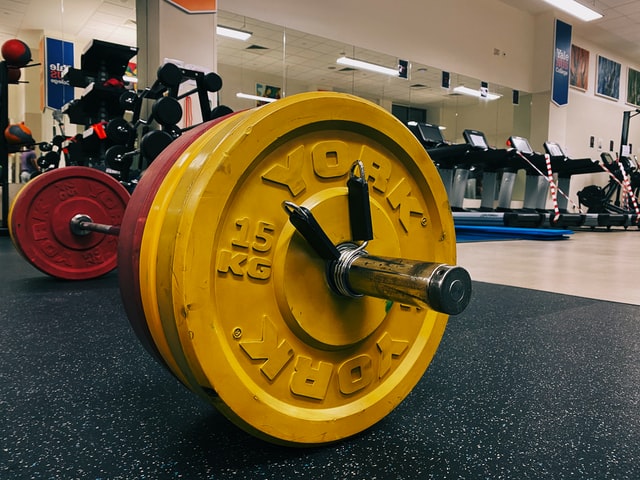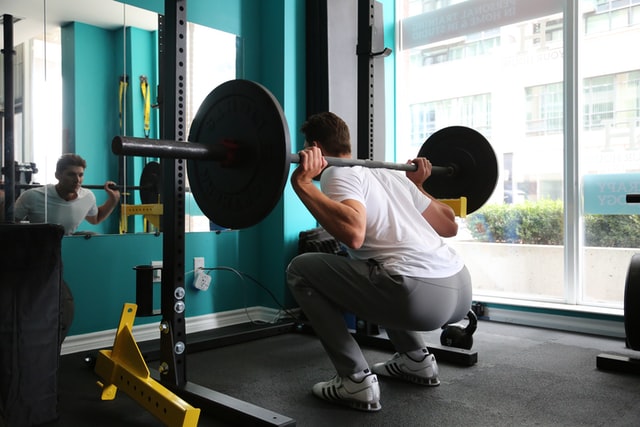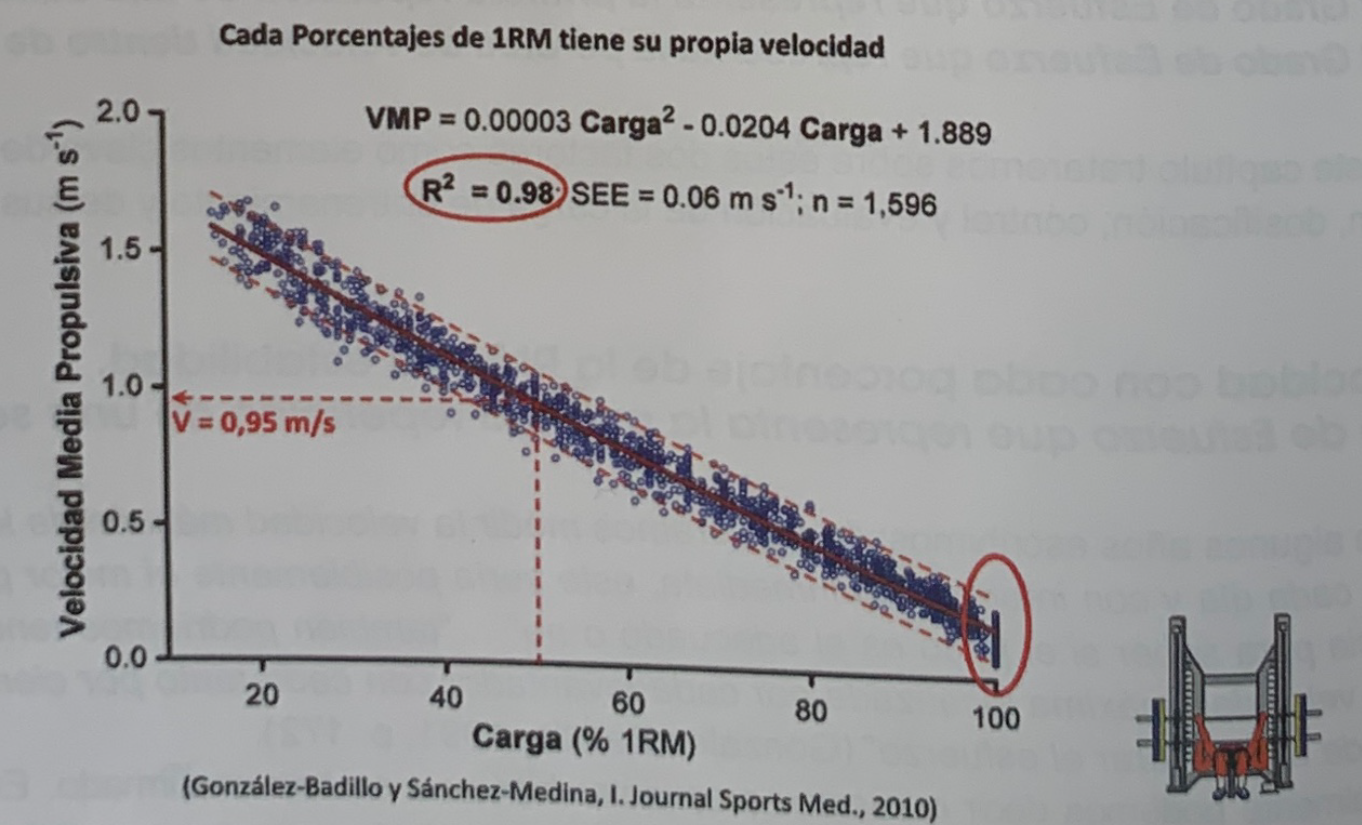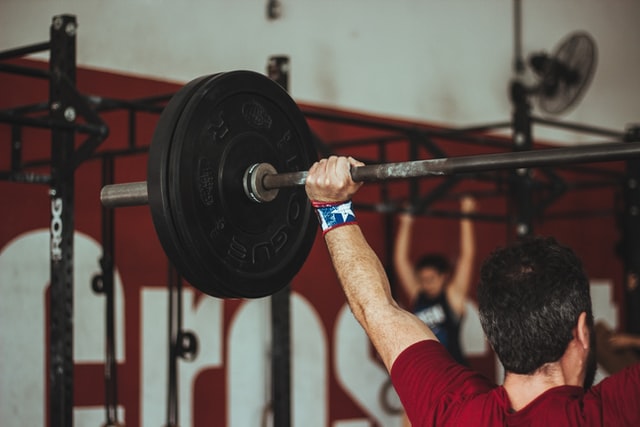execution speed
In this article he focuses on the speed of execution as a reference for training programming, dosage and control. In the previous article on Character of Effort (EC) some ideas related to speed of execution have been introduced that may be useful.
In this series of articles we deal with some of the most important concepts of strength training, collecting notes from the recently published book Strength, Speed and Physical and Sports Performance written by renowned researchers Juan José González Badillo and Juan Ribas Serna.
SUMMARY
- The speed at which each percentage of the RM is performed is very stable depending on each exercise.
- Loss of speed is shown to be an important predictor of metabolic and hormonal stress.
- For the same loss of speed, each person may have performed a different number of repetitions before the same load.
- Using the speed of execution as a reference to dose and control the training far exceeds what the 1RM percentage provides
A few years ago it was said: “If the maximum speed of the movements could be measured every day and with immediate information, this would possibly be the best point of reference to know if the weight is adequate or not”… “a certain decrease speed is a valid indicator for suspending training or lowering the weight of the bar”… “we could also have recorded the maximum speed reached by each lifter with each percentage, and based on this, assess the effort” ( González Badillo, 1991, p.172).

It is based on the assumption that although the value of 1RM can change between different days, the speed at which each percentage of the RM is performed is very stable. Therefore, speed control could inform us with more precision about what real percentage or what effort is being made at each moment. This hypothesis, proposed in 1991 (González Badillo, 1991, p. 172), when we said “we could also have recorded the maximum execution speed reached by each lifter with each percentage, and based on this, assess the effort… ”, has been confirmed, because each percentage of 1RM has its own speed (González-Badillo, 2000; González-Badillo and Sánchez-Medina, 2010).
Therefore, the own speed of each percentage of 1RM determines the real effort. This means that the speed of the first repetition of a set determines the degree of effort that the load represents. Thus, the training load (weight) is determined by the speed of the first repetition, therefore, what must be programmed is not the percentage of 1RM, but the speed of execution of the first repetition of the series.
But speed control not only allows us to know very precisely the true effort that a given load represents when doing the first repetition, but also allows us to know in what proportion or percentage speed is lost as repetitions are made within from the series.
And this is important because the loss of speed in the series is a highly valid indicator to know the degree of effort that the subject is making, since it presents a high relationship with indicators of the degree of mechanical, metabolic and hormonal stress caused by the exercise. training.
loss of speed is shown to be an important predictor of metabolic and hormonal stress
Thus, we found high relationships between the loss of velocity in the series and the loss of velocity with the load that was moving at 1 m/s before the effort, both in the bench press (1= 0.97) and in the squat. (r = 0.91), and with the loss of height (loss of speed) in the jump after the effort (r = 0.92), with ammonium (R* = 0.93) and lactate (r = 0.95-0.97) (Sánchez-Medina and González-Badillo, 2011).
Testosterone (r = 0.83), growth hormone (r = 0.82) and insulin (r = 0.88) are also discharged, and these relationships increase for ammonium (p = 0.94 -96) and lactate (p = 0.98) when using Spearman’s rank correlation coefficient (data from the same previous study, but not yet published. Sánchez-Medina’s Doctoral Thesis, 2010).
All these relationships indicate that the greater the loss of speed in the series, the greater the mechanical stress, that is, the greater the effort, at the same time that the loss of execution speed is shown to be an important predictor of metabolic stress and hormonal.

The question that arises at the moment is what should be the optimal loss of speed in each case. This question, of course, does not have an easy answer, but being able to formulate it and have the appropriate mechanical and physiological data available to try to find an answer is already a great advance. In fact, at this time we could give an indicative and useful answer for most of the subjects.
For example, ammonium is practically unchanged in the bench press and full squat exercises if the number of repetitions performed does not exceed half of the repetitions that can be performed (Sánchez-Medina and González-Badillo, 2011). That the ammonia remains at its resting values means that the emergency pathway of energy production, which is responsible for the increase in ammonia, has not been put into operation.
This path consists of the fact that, given the high and continuous demand for energy, it is not enough to use ADP+CP to produce ATP and the system has to resort significantly to the use of 2 ADP (ADP+ADP) to produce ATP, which which leads to the production of adenosine monophosphate (AMP), inosine monophosphate (IMP) and the degradation into ammonia (NH3) and ammonium (NH4), hypoxanthine, xanthine uric acid, formation of free radicals and losses of purines, this supposes a loss nucleotides (Hellsten-Westing et al., 1993), which can lead to chronic ATP depletion and increased recovery time if sessions that significantly trigger these processes are frequently repeated (Stathis et al. ., 1994, 1999).
If we also know, from extensive practical experience, that doing half or less of the repetitions that can be performed produces notable improvements in muscular strength and sports performance, It would not be very advisable to frequently exceed (in some cases it would never be necessary) half of the repetitions that can be done in a series.
it would not be very advisable to frequently exceed (in some cases it would never be necessary) half the repetitions that can be done in a series
If we analyze the relationship between the loss of speed in the series and the number of repetitions performed, we can state that in the bench press exercise the loss of speed when half of the possible repetitions have been done is between 25 and 30% of the speed of the first repetition, and that in the complete squat the loss of speed of execution in the same conditions would be approximately 15-20%.
Therefore, if it is possible to know what degree of effort each percentage of speed loss means, the application of speed as a way of training control is very useful, probably the best procedure, using the mechanics way, to know with high precision and immediately the training load.

Knowledge of these data would allow not only to program the intensity or degree of effort based on the speed of the first repetition, but also to determine the degree of effort in the series, by being able to decide the loss of Speed that is allowed in the series itself.
By way of example, at this time we can anticipate that in the exercise of the bench press, the relationship between the percentage of speed loss in the series (PPVS) and the average percentage of repetitions performed in the series (PMRR), for the intensities of 50, 55, 60, 65 and 70% of the RM is practically the same.
The percentage of repetitions performed for the same loss of speed must be 2.5% higher when the relative intensity is 75%, 5% higher for 80% and 10% higher for 85% (González-Badillo et al., 2017).
The data corresponding to the intensities between 50 and 70% appear in Table 1.

Tabla 1. Loss of speed in the series and average percentage of repetitions performed with intensities of 50 to 70% of the RM in bench press.
- PPVS: Percentage loss of speed in the series.
- PMRR: Mean percentage of repetitions performed.
- SD: standard deviation.
- CV (%): Coefficient of variation.
for the same loss of speed in the series, each person may have performed a different number of repetitions under the same relative load
It can be seen that, given the low CV values, the PMRR for the different percentages are practically the same. Therefore, when repetitions are performed at the maximum speed possible with any of these RM percentages, the percentage of repetitions performed for a given loss of execution velocity in the series can be known with considerable precision.

It should be remembered here that for the same loss of speed in the series, each person may have performed a different number of repetitions under the same relative load. This means an important advance in the precision to quantify and assess the CE in the series and training session. One more application of speed as a reference to dose and control training derives from the fact that each exercise has its own speed for its RM (González-Badillo, 2000).
The speed at which the RM of an exercise is reached determines its characteristics and its own training intensities for each objective.
Although, as we will see in later chapters, the load with which maximum power is reached is not relevant either for training dosage or for assessing its effect, these loads are determined precisely by the speed of the RM of each exercise. For example, the faster the speed with which the RM of an exercise is reached, the greater the percentage with which the maximum power is reached in the exercise.
There is a very high positive trend between the own speed with the RM in four exercises (snatch, power clean, squat and bench press) and the percentage of the RM with which maximum average power is reached (r = 0.94). (González-Badillo, 2000). It must be taken into account that these power values are calculated through the product of the force and velocity values provided by a linear velocity or position meter, in which the force is determined by the equation F = m( g+a), and the speed is measured directly by displacing the charge (mass).
The speed at which the RM is reached can range from less than 0.2 m/s in the bench press exercise to values close to 1 m/s in the power clean or snatch. These observations confirm that, depending on the exercise with which you train, the same percentage can mean a very different magnitude and type of load, and that to obtain the same effect, you would have to use different percentages.
For example, if a subject intended to train with the maximum average power load in the bench press, he would have to train with 37-40% of the RM, while in the power clean he would have to train with 87% of the RM. Therefore, if we train both exercises, for example, with 80% of their respective RMs, in the case of the bench press we will be training with a load well above that with which maximum power is reached and in the case of the power clean with a load below that of maximum power.

an exercise like the full squat should never be trained with loads greater than 80% of the RM
However, and use this idea to better understand the consequences of, for example, “training with the maximum power load” in all the exercises, a training with 37-40% of the RM in the bench press, with 6 -8 repetitions per series, it is a very light effort that anyone can do at any time, and its effect, load and The degree of fatigue would be very low, however, training with 87% of the RM in a clean exercise is a significant effort, which is very close to the RM of the clean exercise.
Another example could be the following: for the same subject or group of subjects practicing a sport, an exercise like the full squat should never be trained with loads greater than 80% RM (personal suggestion based on extensive experience and results of competition studies), while this same group of subjects could always train, from the beginning of their sporting life, at least with loads equal to or greater than 75-80% of the real RM in the power clean exercise.
These differences in training loads are due, especially, to the fact that the speeds of the RMs of both exercises are very different, much higher in the power clean than in the squat.
From all the above it follows that use the speed of execution as a reference to dose and control the training It far exceeds what the 1RM percentage provides and comes to offer the same contributions as the Character of Effort (it really is another way of applying the CE) but with a much higher precision and eliminating the risk of subjectivity.
Therefore, the existence of a high relationship between speed and the different percentages of 1RM, as well as between the loss of speed in the series and the percentage of repetitions performed in the series allows:
- Evaluate the strength of a subject without the need to perform a 1RM test or an XRM test at any time.
- Determine with high precision what actual percentage of 1RM the subject is using as soon as they perform the first repetition with a given load at the maximum speed of execution possible.
- Program, dose and control training with high precision through speed, and not through a percentage of 1RM.
- If the speed is measured every day, it can be determined if the load proposed to the subject (kg) faithfully represents the true degree of effort (% of real 1RM) that represents the first repetition and the degree of effort that represents the number of repetitions performed (valued for the loss of speed in the series).
- Use strength training with all subjects, from children to the most advanced athletes or adults and seniors you intend. improve your health, without the need to do maximum effort tests (1RM, or XRM, for example) in any case.
- Estimate the improvement in performance each day without the need to perform any tests, simply by measuring the speed with which an absolute load moves. YES, for example, the difference in speed between 70 and 75% of the RM of a specific exercise is 0.08 m/s, when the subject increases speed by 0.08 m/s under the same absolute load , the load with which he trains will represent 5% less than the RM of the subject at that moment, which, naturally, will have increased in value. Naturally, if what is produced is a loss of speed under the same absolute load, we can be quite sure that the subject is below its previous performance, and in an average proportional to the loss of speed.
- Estimate, through the loss of speed in the series, the percentage that represents the number of repetitions performed with respect to those achievable under any load.
- Being able to calculate the Effort Index, probably the best indicator of the degree of effort and fatigue that can be used to estimate these training variables.

Therefore, as we have indicated, what is programmed or should be programmed is not the percentage of 1RM, but the speed of execution of the first repetition of a series (Of course, if we associate the percentages with their corresponding speeds, it would be indifferent to use one procedure or another) and the loss of speed in the series allowed. The speed with each percentage of 1RM is not modified or it does so in a very slight way when the subject modifies the value of his RM after a period of training.
What most determines the slight speed changes between a test and a post-test with each percentage of 1RM, if they occur, is the speed with which the RM is performed and measured (González-Badillo and Sánchez-Medina , 2010), in such a way that two MRIs could not be compared if they were performed at different speeds. But this problem disappears if, as we have indicated, we never measure the RM, neither to take it as a reference to program the training nor to assess its effect, but instead we use the speed and speed changes before the same loads for both objectives.
what is programmed or should be programmed is not the percentage of 1RM, but the speed of the first repetition of a series
Our proposal, therefore, is that the average propulsive velocity should always be used to assess the training load and the performance of the subject (if necessary, the article Sánchez-Medina et al., 2010 can be consulted).













